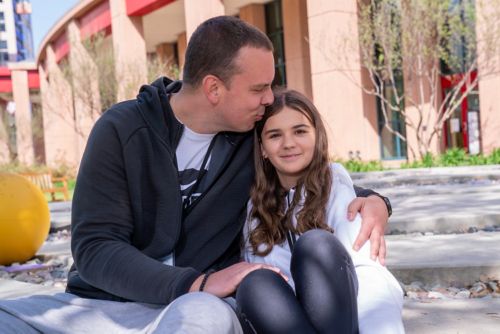Anti-GD2 therapy triggers immune response
Anti-GD2 therapy is a type of immunotherapy. It targets GD2, which is on the surface of neuroblastoma cells. GD2 acts like a flag on the surface of the cells. The anti-GD2 therapy is a monoclonal antibody. It recognizes the flag on the tumor cells, binds to the GD2, and triggers the immune system to attack and kill the cancer. Because GD2 is not present on many healthy cells in the body, the hope is that the targeted treatment kills the cancer cells without harming the healthy cells.
When Sara arrived, St. Jude had a new clinical trial, NB2012, that added antibody treatment to the beginning of therapy with chemotherapy. This treatment is called chemoimmunotherapy. It had not been previously given to patients with newly diagnosed high-risk neuroblastoma.
“We knew it worked for patients with relapsed disease, but we did not know if it would work in newly diagnosed patients,” says Sara Federico, MD, Sara’s oncologist and director of the Solid Tumor Division at St. Jude. “Sara’s family placed a ton of trust in us, knowing that these were early days of the clinical trial. When I initially met them, Sara was very sick, and time was of the essence. I shared the rationale of adding the immunotherapy to the chemotherapy but was honest about the risks and unknowns. We made sure that they knew what they were getting into. They trusted us.”
NB2012 treatment worked for Sara, now 13. The inclusion of anti-GD2 therapy with chemotherapy is now being studied in a large international trial led by Dr. Federico.
Bojan’s refusal to give up saved his daughter’s life.
“They told us zero chance to live until 2015,” Bojan says. “Today, we are in 2025. So, I tell parents, ‘Never lose hope. There is hope.’”
Sara’s treatment ended in May 2015. It got rid of the cancer, and the cancer has not returned. Sara and Bojan went back to Belgrade. Since then, Sara’s family has grown to include 3 more girls, Anna, 10; Sofija, 9, and Petra, 7. Sara plays volleyball and loves dancing.
Looking at long-term effects of immunotherapy
Now, 10 years after her treatment, Sara is part of a St. Jude Lifetime Cohort (St. Jude LIFE) study called LEGACY. It will help doctors determine what long-term side effects result from anti GD-2 therapy given with high-risk neuroblastoma therapy.
“The success of anti GD-2 therapy administered with chemotherapy is exciting,” Federico says. “But we know that any treatment comes with a cost. We need to better understand those risks so we can mitigate them if possible.”
The LEGACY study will take an in-depth look at potential long-term side effects of treatments for patients enrolled in the NB2012 protocol for the treatment of high-risk neuroblastoma. Patients treated on NB2012 had a more than 73% 3-year relapse-free survival rate. Previous studies have shown 3-year relapse-free survival rates around 51% using conventional therapy.
This type of study would not be possible without St. Jude LIFE and its participants, Federico says.
“St. Jude LIFE is a gift,” Dr. Federico says. “Participating in St. Jude LIFE is a gift that survivors give to the patients who come behind them. It allows the medical team to learn about our therapies and incorporate changes to lessen treatment toxicities in the future. The knowledge gained through St. Jude Life teaches us how to better care for our survivors and plug them into appropriate follow up for late effects. To me, participation in St. Jude Life is the definition of altruism.”



